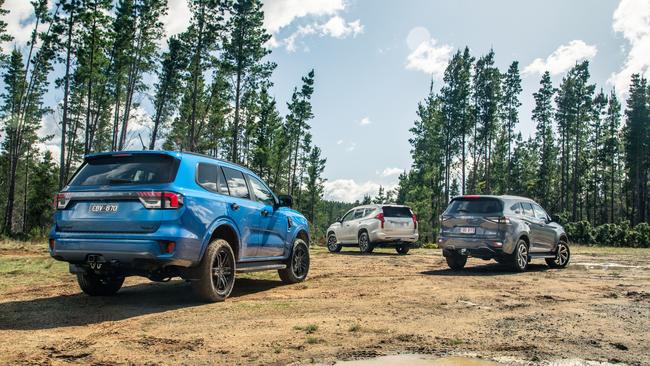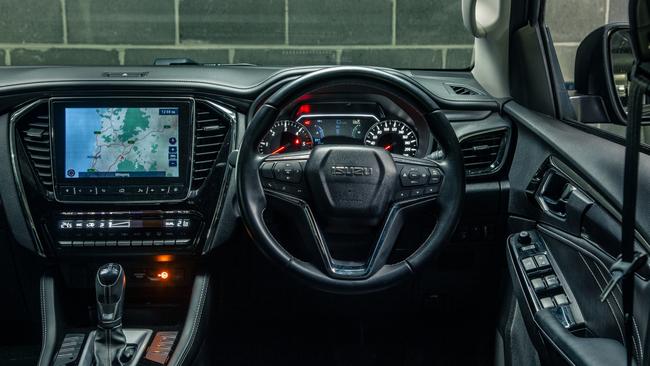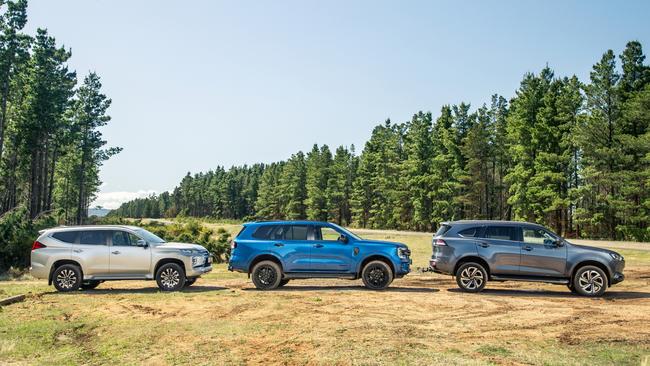2022 Ford Everest v Isuzu MU-X v Mitsubishi Pajero Sport comparison review
These three vehicles are double threats, blending the ability to ferry the family around in comfort and head off road for adventures. SEE WHICH WINS.
Car Advice
Don't miss out on the headlines from Car Advice. Followed categories will be added to My News.
What sort of premium would you pay for the best car in a segment? And how long would you be willing to wait for it? Those are the sort of questions faced by many folk looking to get hold of a new car today, especially one with off-road ability.

FORD EVEREST
As with the Ranger ute that shares its core structure, the Ford Everest is the best car in this class.
The Everest is the newest model in a category with long life cycles, which means it benefits from modern tech such as forward and reverse auto emergency braking as standard, along with active cruise control, blind-spot monitoring, rear cross-traffic alerts and more.
It’s the only car in this category with nine airbags including centre protection between the driver and passenger.

A clever app lets you access the car remotely, the digital dash works well and an enormous 12-inch central infotainment screen is a winner.
An adaptive full-time four-wheel drive system promises traction in everyday driving, joined by a 10-speed auto and sophisticated drive modes to suit conditions such as sand, snow and mud.
We tested the Everest in mid-grade “Sport” trim with a 3.0-litre V6 turbo diesel engine that makes 184kW and 600Nm. It blends luxuries such as heated and cooled leather seats with an exterior stripped of chrome.

The Everest feels planted and stable, helped in some circumstances by its comparatively heavy weight. Composed suspension and class-leading refinement make for effortless progress on tarmac and dirt. The down side is 8.5L/100km fuel use and larger dimensions that can make it feel unwieldy in town. There’s also the small matter of its price – $69,090 plus on-roads, or about $75,000 drive-away – and wait lists that stretch into 2023.

ISUZU MU-X
The seven-seat cousin to Isuzu’s D-Max ute came close to eclipsing the previous generation Everest earlier this year. Value is core to the Isuzu MU-X. Normally sold for $67,400 plus on-road costs (about $73,000 drive-away), the range-topping MU-X LS-T is on sale for a sharp $65,990 drive-away.

The Isuzu is one of the more modern machines in the class. It has eight airbags – including front centre protection – and impressive driver aids that come close to matching the Ford, including auto emergency braking, active cruise control, blind-spot monitoring and more.
Isuzu’s 9-inch infotainment screen with wireless smartphone mirroring was best-in-class until the new Everest arrived and its leather seats are heated, but not cooled.
Isuzu backs the wagon with a six-year, 150,000 kilometre guarantee.

The Isuzu’s 3.0-litre four-cylinder engine uses 8.3L/100km of diesel to make 140kW and 450Nm, figures that lag behind the more powerful Ford. As with its rivals here, the Isuzu has proper four-wheel-drive with a low-range transfer case and locking rear differential.
But its six-speed automatic transmission is short on ratios, placing additional strain on an adequate if not impressive engine. The Isuzu’s truck-like motor lacks the effortless muscle and impressive refinement of the Ford but it gets the job done. It’s a similar story on the road, where the MU-X is capable but not particularly polished, with a somewhat bumpy ride and noticeable wind noise.

MITSUBISHI PAJERO SPORT
Pitched at buyers who aren’t worried about bragging rights, Mitsubishi’s Triton-based Pajero Sport is smaller than the Ford and Isuzu. Its compact dimensions result in a less roomy cabin and an especially tiny boot capacity with third-row seats in place.
But it wins points for being the most affordable model, priced from $64,490 drive-away in range-topping GSR trim (though we could only get hold of the cheaper Triton Sport GLS for our photography). A five-year warranty is standard and Mitsubishi doubles that if you service through its dealers.

It has an 8-inch touchscreen with satnav, Apple CarPlay and Android Auto. Safety is covered by seven airbags, auto emergency braking, active cruise control, blind-spot monitoring, rear cross-traffic alerts and a 360-degree camera.
It has heated leather seats and is the only car here with sporty shift paddles on the steering wheel.
Power comes from a 2.4-litre, four-cylinder turbo diesel engine that makes 133kW and 430Nm – comparatively slender figures accompanied by less thirsty 8L/100km fuel use.
An eight-speed automatic transmission helps make the most of the motor, helped by proper all-wheel-drive.

The Pajero Sport is less attractive to adventurers, as it has the least ground clearance or water wading ability and can only tow 3100 kilos (the Ford and Isuzu pull up to 3.5 tonnes).
It feels the most ute-like of the trio to drive, with a bouncy ride and stressed engine.
VERDICT
The Pajero Sport makes sense at recommended retail prices, but the discounted Isuzu is a better bet. Ford’s Everest is unquestionably the best car, as long as you’re prepared to pay a premium and be patient.
FORD EVEREST SPORT VITALS
PRICE About $75,000 drive-away
ENGINE 3.0-litre V6 turbo diesel, 184kW and 600Nm
WARRANTY/SERVICE 5-yr/u’ltd km, $1645 for 5 yrs
SAFETY 9 airbags, front and rear auto emergency braking, lane-keep assist, blind-spot monitoring, rear cross-traffic alert
THIRST 8.5L/100km
BOOT 259 litres
SPARE Full-size
ISUZU MU-X LS-T VITALS
PRICE $65,990 drive-away
ENGINE 3.0-litre 4-cyl turbo diesel, 140kW and 450Nm
WARRANTY/SERVICE 6-yr/150,000km, $2315 for 5 yrs
SAFETY 8 airbags, auto emergency braking, radar cruise, lane-keeping and blind-spot assist, rear cross-traffic alert
THIRST 8.3L/100km
BOOT 311 litres
SPARE Full-size
MITSUBISHI PAJERO SPORT GSR VITALS
PRICE $64,490 drive-away
ENGINE 2.4-litre 4-cyl turbo diesel, 133kW and 430Nm
WARRANTY/SERVICE 5-yr/u’ltd km, $2495 for 5 yrs
SAFETY 7 airbags, auto emergency braking, active cruise control, blind-spot monitoring, rear cross-traffic alert
THIRST 8L/100km
BOOT 131 litres
SPARE Full-size


